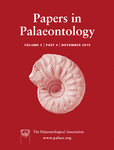Reg. Charity No. 1168330

Triassic megaspore assemblages from Svalbard, Arctic Norway, are described for the first time based on the analysis of the Upper Triassic (Carnian–Norian/Rhaetian) Kapp Toscana Group on the island of Hopen. Two megaspore zones are described: the late Carnian ‘Dijkstraisporites beutleri Zone’ (undifferentiated De Geerdalen Formation), and the Norian/Rhaetian ‘D. beutleri–Verrutriletes preutilis Zone’ (Svenskøya Formation). Megaspores are attributed to heterosporous lycopsids, and probably correspond to the microspore Aratrisporites, which was observed in palynological preparations. Megaspore occurrence was highest in delta‐plain and associated with lake‐mire deposits. However, their close association with marine microfossils suggests episodic marine influence and is consistent with previous interpretations that some Triassic lycopsids occupied marginal marine habitats. The absence of megaspores in the overlying Hopen Member and Flatsalen Formation is probably related to a marine transgression during the early Norian, as indicated by the recovery of low diversity assemblages of agglutinated foraminifera. The transition to ostracod‐dominated microfaunas in the middle part of the formation is consistent with a regionally extensive maximum flooding surface, prior to a return to megaspore‐dominated assemblages in the fluvio‐deltaic deposits of the Svenskøya Formation. Despite the abundance of their mega and microspores, lycopsid fossils are almost entirely absent within palaeobotanical collections from the island, which we ascribe to their herbaceous habit and consequent low preservation potential. The results of this study show lycopsids to be an important component of the local ecosystem and thus contribute to a more complete understanding of the Late Triassic floras of northern‐most Pangaea.